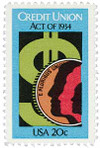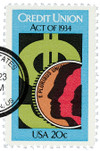
# 2075 - 1984 20c Credit Union Act 50th Anniversary
U.S. #2075
1984 20¢ Credit Union Act
- Stamp commemorates the 50th anniversary of the Federal Credit Union Act
- Second stamp to include the dollar sign as a central part of the vignette
- The third of four 1984 government agency stamps that were printed in one sheet using the “quadrant” plate printing technique
Stamp Category: Commemorative
Value: 20¢, rate for first-class mail
First Day of Issue: February 10, 1984
First Day City: Salem, Massachusetts
Quantity Issued: 106,800,000
Printed by: Bureau of Engraving and Printing
Printing Method: Photogravure
Format: Pane of 50 in Sheets of 200 (1 pane each of #2071, 2074, 2075, and 2081)
Perforations: 11
Why the stamp was issued: To commemorate the 50th anniversary of the Federal Credit Union Act.
About the stamp design: This was the second US stamp to ever include a dollar sign as a central element of the vignette (not as part of the denomination). The stamp features a large dollar sign in the background with a coin in front of it with the words “E Pluribus Unum” (“Out of Many, One”). The phrase had been included in Seal of the United States and on coins and paper money since 1795. The three profiles on the coin are meant to show that savers of all ages use credit unions.
About the printing process: This stamp was created using a relatively new “quadrant” plate printing technique. (It had been used the year before for Official stamps.). The USPS created 200-subject plates with 50-stamp panes that each had a different stamp. The Federal Deposit Insurance Corporation stamp (#2071) was in the upper left quadrant, the Soil and Water Conservation stamp (#2074) in the upper right pane, the National Archives stamp (#2081) in the lower left pane, and the Federal Credit Union stamp (#2075) in the lower right pane.
First Day City: This stamp was issued at the Hawthorne Inn in Salem, Massachusetts. Salem was selected because it was the birthplace of Edward Filene, who’s considered the “Father of US Credit Unions.”
Unusual fact about this stamp: There have been misperforated examples of this stamp in which the perforations run down the middle of the design.
History the stamp represents: A credit union is a financial cooperative chartered by the federal government and owned by its members. Credit unions offer members a safe place to save and borrow money at reasonable rates. Surplus income is returned to members in the form of dividends. Membership is limited to groups of people with a common bond, such as types of industry or employment.
With the passage of the Credit Union Act of 1909, Massachusetts became the first state to enact legislation to regulate the cooperatives. Modeled after the Massachusetts legislation, the Federal Credit Union Act of 1934 established a nationwide system to charter and supervise the cooperatives. The number of credit unions in the United States has grown steadily since 1934. Today more than 9,500 credit unions offer a full range of services to 82 million members.
U.S. #2075
1984 20¢ Credit Union Act
- Stamp commemorates the 50th anniversary of the Federal Credit Union Act
- Second stamp to include the dollar sign as a central part of the vignette
- The third of four 1984 government agency stamps that were printed in one sheet using the “quadrant” plate printing technique
Stamp Category: Commemorative
Value: 20¢, rate for first-class mail
First Day of Issue: February 10, 1984
First Day City: Salem, Massachusetts
Quantity Issued: 106,800,000
Printed by: Bureau of Engraving and Printing
Printing Method: Photogravure
Format: Pane of 50 in Sheets of 200 (1 pane each of #2071, 2074, 2075, and 2081)
Perforations: 11
Why the stamp was issued: To commemorate the 50th anniversary of the Federal Credit Union Act.
About the stamp design: This was the second US stamp to ever include a dollar sign as a central element of the vignette (not as part of the denomination). The stamp features a large dollar sign in the background with a coin in front of it with the words “E Pluribus Unum” (“Out of Many, One”). The phrase had been included in Seal of the United States and on coins and paper money since 1795. The three profiles on the coin are meant to show that savers of all ages use credit unions.
About the printing process: This stamp was created using a relatively new “quadrant” plate printing technique. (It had been used the year before for Official stamps.). The USPS created 200-subject plates with 50-stamp panes that each had a different stamp. The Federal Deposit Insurance Corporation stamp (#2071) was in the upper left quadrant, the Soil and Water Conservation stamp (#2074) in the upper right pane, the National Archives stamp (#2081) in the lower left pane, and the Federal Credit Union stamp (#2075) in the lower right pane.
First Day City: This stamp was issued at the Hawthorne Inn in Salem, Massachusetts. Salem was selected because it was the birthplace of Edward Filene, who’s considered the “Father of US Credit Unions.”
Unusual fact about this stamp: There have been misperforated examples of this stamp in which the perforations run down the middle of the design.
History the stamp represents: A credit union is a financial cooperative chartered by the federal government and owned by its members. Credit unions offer members a safe place to save and borrow money at reasonable rates. Surplus income is returned to members in the form of dividends. Membership is limited to groups of people with a common bond, such as types of industry or employment.
With the passage of the Credit Union Act of 1909, Massachusetts became the first state to enact legislation to regulate the cooperatives. Modeled after the Massachusetts legislation, the Federal Credit Union Act of 1934 established a nationwide system to charter and supervise the cooperatives. The number of credit unions in the United States has grown steadily since 1934. Today more than 9,500 credit unions offer a full range of services to 82 million members.










